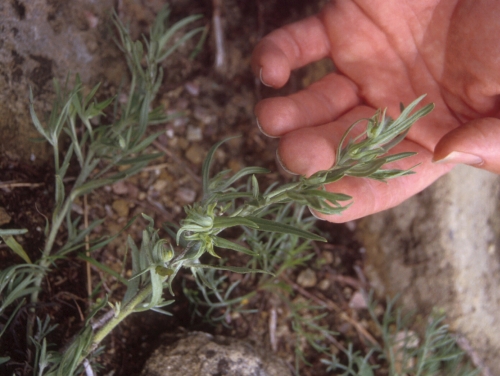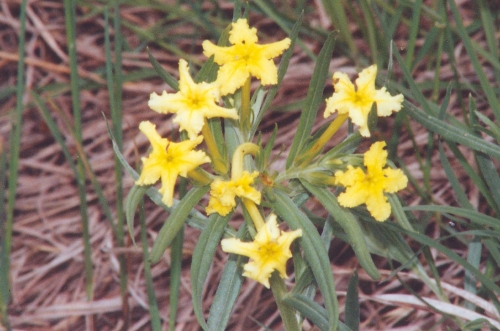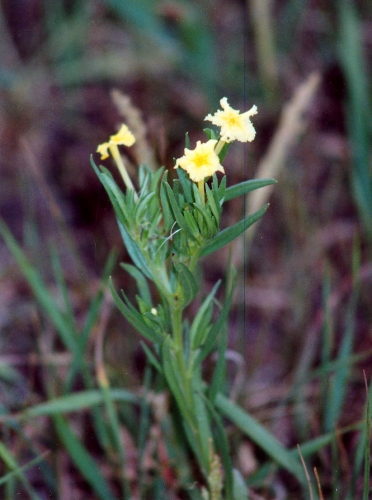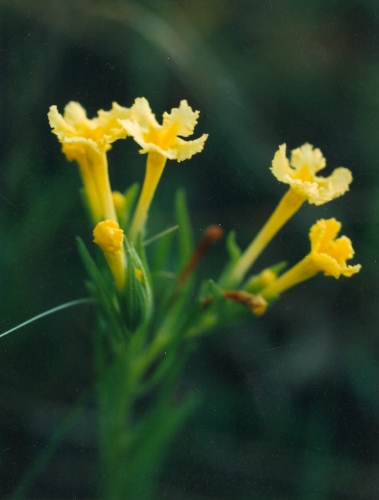Plants and Animals
Lithospermum incisum Narrow-leaved puccoon
Key Characteristics
Small forb of dry sandy prairies; stem often decumbent, bearing numerous narrowly lanceolate leaves (4 mm wide) and closely appressed hairs; flowers bright yellow, with 5 fringed petals uniting to forb a floral tube in terminal clusters; nutlets finely pitted.
Status and Rank
US Status: No Status/Not Listed
State Status: X - Presumed extirpated (legally 'threatened' if rediscovered)
Global Rank: G5 - Secure
State Rank: SX - Presumed extirpated
Occurrences
| County | Number of Occurrences | Year Last Observed |
|---|---|---|
| St. Clair | 1 | 1915 |
Information is summarized from MNFI's database of rare species and community occurrences. Data may not reflect true distribution since much of the state has not been thoroughly surveyed.
Habitat
Narrow-leaved puccoon is known only from a few collections near Port Huron, where this species occurred in dry sandy ground near the Lake Huron shore. It has not been documented in the state since the early 1900s.
Natural Community Types
For each species, lists of natural communities were derived from review of the nearly 6,500 element occurrences in the MNFI database, in addition to herbarium label data for some taxa. In most cases, at least one specimen record exists for each listed natural community. For certain taxa, especially poorly collected or extirpated species of prairie and savanna habitats, natural community lists were derived from inferences from collection sites and habitat preferences in immediately adjacent states (particularly Indiana and Illinois). Natural communities are not listed for those species documented only from altered or ruderal habitats in Michigan, especially for taxa that occur in a variety of habitats outside of the state.
Natural communities are not listed in order of frequency of occurrence, but are rather derived from the full set of natural communities, organized by Ecological Group. In many cases, the general habitat descriptions should provide greater clarity and direction to the surveyor. In future versions of the Rare Species Explorer, we hope to incorporate natural community fidelity ranks for each taxon.
Associated Plants
No data on associates are available for Michigan. Elsewhere, this plant occurs with such prairie associates as silvery aster, side-oats grama grass, flowering spurge, prairie dropseed, little bluestem, lead plant, pale coneflower, upland white goldenrod, false boneset, and prairie cinquefoil.
Management Recommendations
The primary need at present is inventory to determine if the species is extant. Management would likely entail methods that promote and maintain prairie grassland habitat, including prescribed fire.
Survey Methods
Random meander search covers areas that appear likely to have rare taxa, based on habitat and the judgment of the investigator.
-
Meander search
-
Survey Period: From third week of May to fourth week of June
-
References
Survey References
- Elzinga, C.L., D.W. Salzer, and J.W. Willoughby. 1998. Measuring and Monitoring Plant Populations. The Nature Conservancy and Bureau of Land Management, Denver. BLM Technical Reference 1730-1. 477pp.
- Goff, G.F., G.A. Dawson, and J.J. Rochow. 1982. Site examination for Threatened and Endangered plant species. Environmental Management 6(4): 307-316
- Nelson, J.R. 1984. Rare Plant Field Survey Guidelines. In: J.P. Smith and R. York. Inventory of rare and endangered vascular plants of California. 3rd Ed. California Native Plant Society, Berkeley. 174pp.
- Nelson, J.R. 1986. Rare Plant Surveys: Techniques For Impact Assessment. Natural Areas Journal 5(3):18-30.
- Nelson, J.R. 1987. Rare Plant Surveys: Techniques for Impact Assessment. In: Conservation and management of rare and endangered plants. Ed. T.S. Elias. California Native Plant Society, Sacramento. 8pp.
Technical References
- Gleason, H. A., and A. Cronquist. 1991. Manual of Vascular Plants of Northeastern United States and Adjacent Canada. 2nd Ed. The New York Botanical Garden, New York, New York.
- Gray, A. 1950. Gray's Manual of Botany; eighth ed. Van Nostrand Reinghold, New York. 1632pp.
- Holmgren, N.H. 1998. Illustrated Companion to Gleason and Cronquist's Manual. Illustrations of the vascular plants of Northeastern United States and adjacent Canada. New York Botanical Garden, Bronx. 937pp.
- Swink, F. and G. Wilhelm. 1994. Plants of the Chicago Region, 4th ed. Indiana Academy of Science, Indianapolis. 921pp.
- Voss, E.G. 1996. Michigan Flora. Part III. Dicots (Pyrolaceae-Compositae). Bulletin of the Cranbrook Institute of Science and University of Michigan Herbarium. 622pp.





